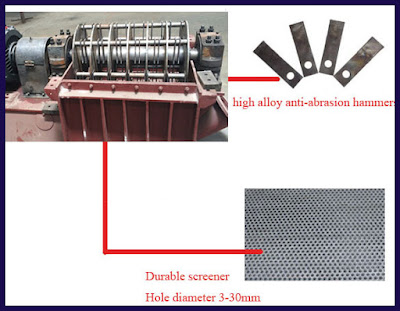Hammer mill consists of feed inlet , hammers, screen, rod and rotor. The hammers swing on the central rotor freely .The rotor spins at a high speed while material is sent into a feed hopper. The material is impacted by hammers and is thereby grinded and then falling through the mesh and the discharging port. It is widely used in foodstuff, chemical , fiber and other granular materials.
The continuous or "twin-spiral" mixer consists of a horizontal, stationary, half-cylinder with revolving helical ribbons placed on a central shaft so as to move materials from one end to the other as the shaft and ribbon rotate inside (Figure 2). Capacity can be from a few litres to several cubic metres. The speed of shaft rotation will vary inversely as the circumference of the outer ribbon; usually optimum between 75-100 metres per minute. Since material travel is from one end to the other, either end may be used for discharge. These mixers may be inverted for cleaning.
Non-continuous or interrupted ribbons are similar to the continuous ribbon mixers except that short sections called "paddles" or "ploughs" are spaced in a spiral round the mixer shaft. Action is different from that of continuous ribbon mixers, and may be more satisfactory for mixing liquids with dry solids. These mixers are made in a wide variety of sizes with travel of the outer diameter of paddles from 100 to 120 metres per minute.
Fig. 2 Continuous ribbon mixer

The transformation of a soft, often dusty feed into a hard pellet is accomplished by compression, extrusion, and adhesion. The general process involves passing a feed mixture through a conditioning chamber where 4 to 6 percent water (usually as steam) may be added. Moisture provides lubrication for compression and extrusion and in the presence of heat causes some gelatinization of raw starch present on the surface of vegetative ingredients, resulting in adhesion. Within 20 seconds of entering the pellet mill, feed goes from an air-dry (about 10-12 percent moisture) condition at ambient temperature, to 15-16 percent moisture at 80-90°C. During subsequent compression and extrusion through holes in a ring' die, friction further increases feed temperature to nearly 92°C. Pellets discharged onto a screen belt of a horizontal tunnel drier or into a vertical screened hopper are air-cooled within 10 minutes to slightly above ambient temperatures and dried to below 13 percent moisture.

Contact :Emilyzhang
Email: emilyzhang@sdshuanghe.com


















